Game week 26 of Allsvenskan is the clash between Helsingborgs IF and Malmo FF at the Olympia. Months ago, Di blåe put four past Alexander Nilsson. Both teams should have enough incentives to give 120% efforts in this game – Olof Mellberg’s men were fighting to avoid relegation. Meanwhile, the guests were looking to reclaim the crown of Sweden.
As the xGs of both sides reflected, it was a close game. Malmö and Helsingborgs’ xG were 1.32 and 1.33, respectively. This tactical analysis is going to dissect the tactics in this game.
Lineups
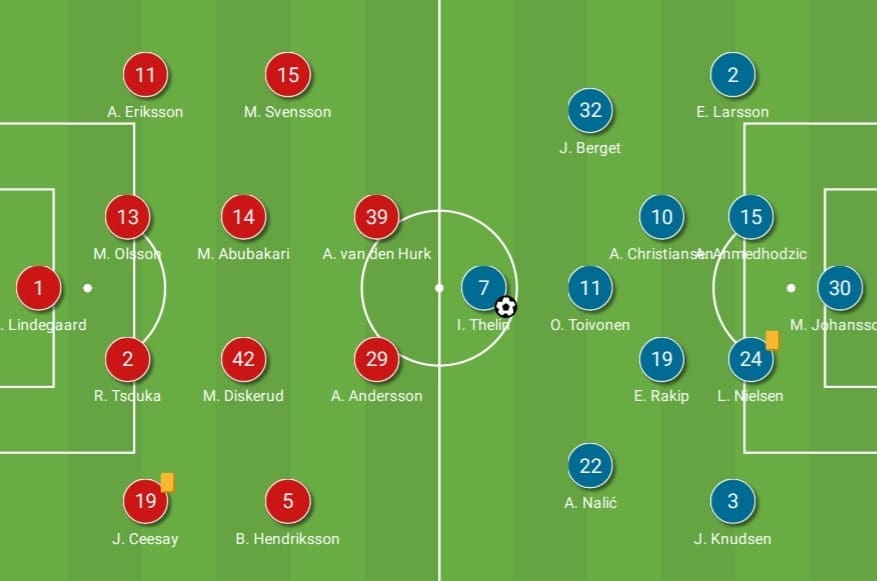
Compared to the previous fixture, there were only two changes from the home side. Anders Lindegaard returned to the goalie. Also, Ravy Tsouka started the game with the former Blackburn Rovers defender – Martin Olsson, replaced Erik Figueroa.
The away team rotated the squad again, welcomed Jo Inge Berget and Isaac Kiese Thelin returning to the squad. Lasse Nielsen partnered with Anel Ahmedhodzic at the centre of the defence. Despite linked with Premier League team Chelsea recently, the young defender is focusing on the game.
Malmö exploiting spaces around the midfield duo
Helsingborgs were defending aggressively in this game instead of sitting in a low block to wait for the opponents. This bold approach worked as Malmö struggled to control the game. Unusually, Tomasson’s men had fewer ball possession (43.47%) than the opponents, they were also much more direct as a result of avoiding ball circulation at the backline.
Di Röe defended in a 4-1-3-2 on most occasions, with a pair of narrow wingers tucking inwards to form the second line. The midfield duo – Mix Diskerud and Mohammed Abubakari should stay in two horizontal zones to add an extra layer in front of the defence. The full-backs generally stepped up early to close the attacking players. The most important was to consistently to pressure the ball, prohibiting the opponents from dictating the rhythm.
When pressing a goal kick, numerically, the home side could man-mark the opponents given the 4-2 shape deployed in the build-up. Therefore, Diskerud had the freedom to step up in order to control the central target.
After Marko Johansson played to either centre-back, Di Röe could identify the vertical half to press. The high press instantly began with players squeezing from at least two angles – vertically and horizontally. Players from the far side should move towards the ball while the midfielders should gain control on the second layer. In those cases, Malmö would not take the risk to play short – they opt for more direct ways to attack.
However, the potential issue was spaces behind the midfield as the defenders seldom pushed higher. Inge Berget, Ola Toivonen and Kiese Thelin could all exploiting those spaces. When Malmö were trying to attack with positional plays, they have strategies to create spaces and exploit them.
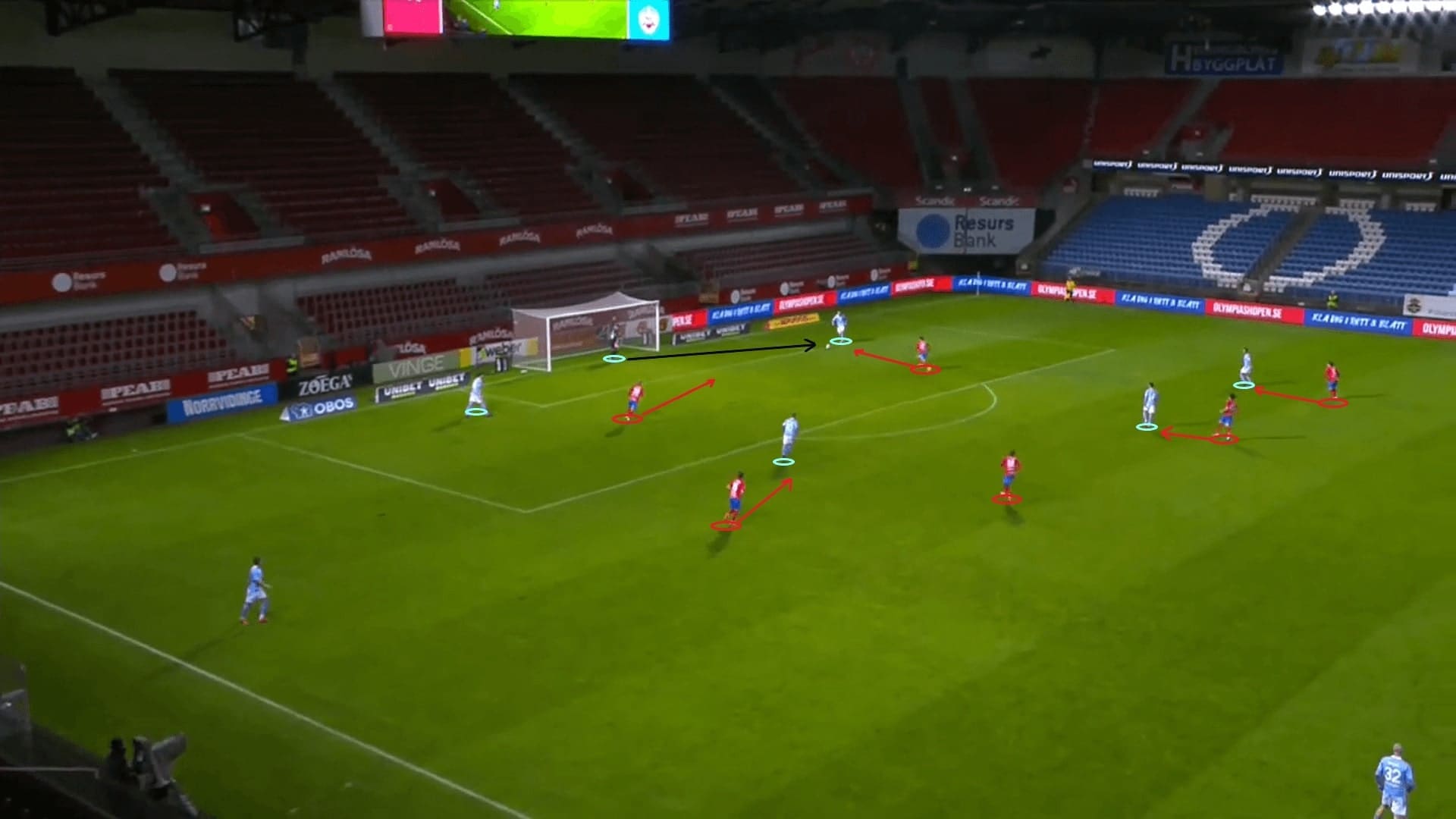
Despite spending efforts to press the opponents, Helsingborgs suffered from insufficient horizontal coverage at the midfield. Apart from using cross-field balls to evade from the player abundant area, Malmö were also good at exploiting spaces around the Diskerud and Abubakari to attack. Di Röe midfield duo could not cover that many spaces.
On paper, the 4-4-2 formations of Helsingborgs only had two midfielders while the 4-2-3-1 of Malmö got three. Therefore, the key to developing an attack was to find the extra man behind the midfield, which was the strength of Toivonen. The experienced Swedish player was extremely good at perceiving and entering spaces to provide passing options for the backline players, then quickly linking to the next option.
In this example, Helsingborgs’ defence was stretched as Eric Larsson’s wide positioning has dragged the winger, opening horizontal gaps and passing lanes between players. Ahmedhodzic was good at ball-playing, when given those gaps, he would always pass vertically. Toivonen dropped as the receiver, then quickly played a one-touch pass to Larsson.
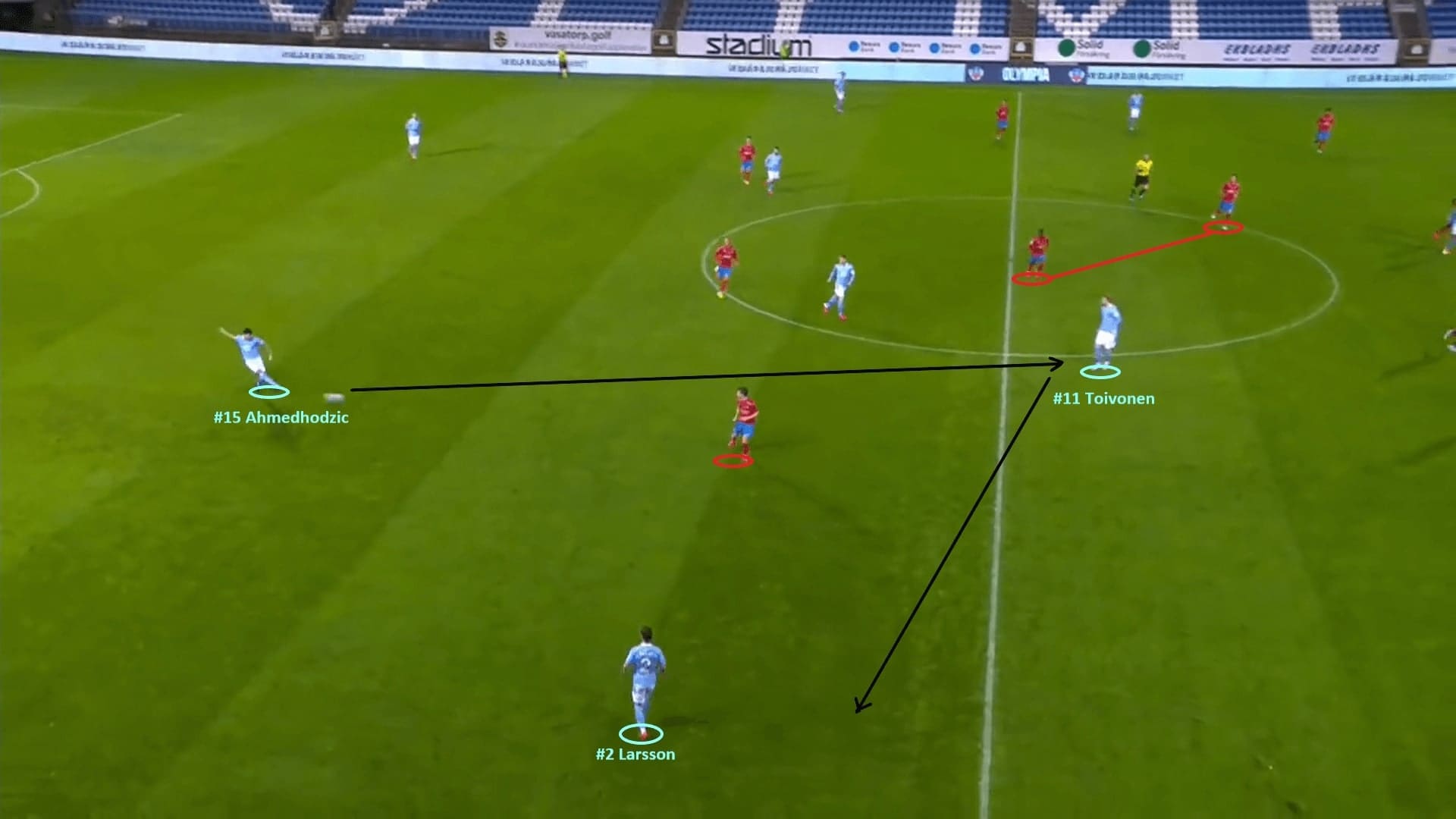
Below was another example to show the more direct approach of Malmö. In this case, the point was Abubakari’s positioning, who inevitably stepped up higher to close one of the midfielders. Meanwhile, the wingers were staying high. Diagonal spaces behind the midfield duo were unprotected.
In this example, Adi Nalic served as the target to receive the lofted pass from the centre-back. Inge Berget was used as the third man as the next option. However, despite all the efforts to bypass the first two layers of the press, Malmö were not quick enough to identify the front players to access the final third. Helsingborgs midfielders were also quick to retreat and drop back whenever the guest played backward. Most of the chances were from the transition phases instead, including Kiese Thelin’s goal.
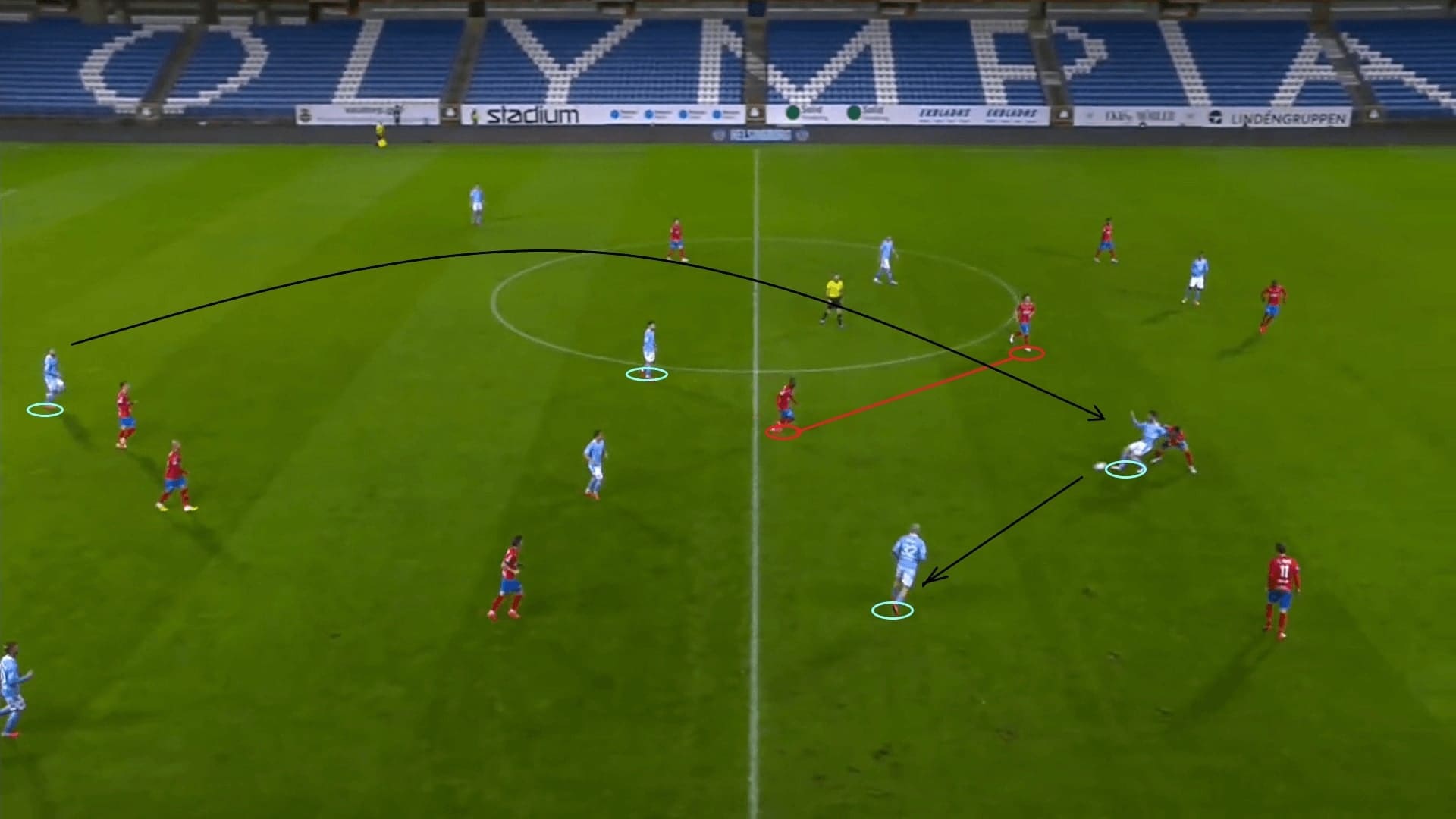
Below shows the top passing links and average positions of Malmö players. 407 passes in the game was much lower than the season average – 514.27. The passing accuracy was also slightly below par, 82.06% was not as good as the team’s season mean – 84.8%.
The linkages of players were not strong. We feel Christiansen and Toivonen should be found more to connect plays. They were the best players of the team, but their influence diminished in this game as not receiving the ball enough during the offensive plays.
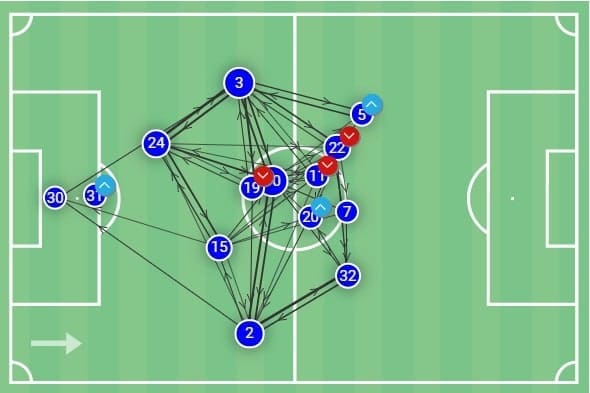
Malmö only had 6 crosses in this game, less than one third of their average 20.58 this season was a result of their struggles to construct an attack. The below crossing graph of the team has shown Di blåe did not gain access to zone 16 and 18, while the early crosses did not gain huge success except the Larsson one that set up Kiese Thelin’s header.
Jonas Knudsen was also more conservative in the game, as he usually supported the attack a lot on the left. The guest’s reliance on transitions to create the attack did not give enough time for the left-back to join the attack.
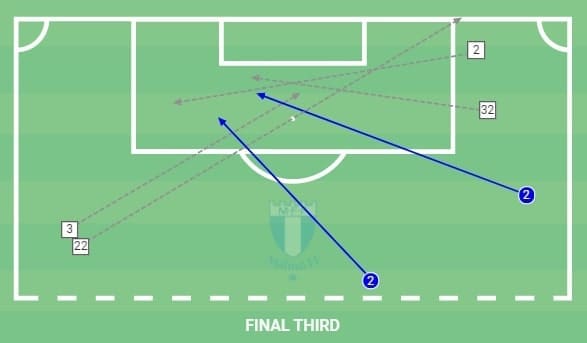
The flexible structure of Helsingborg
Di blåe defensive scheme
Malmö also pressed high in this game, but they were carefully managing spaces between the defence and the midfield. Apart from the defenders, mostly only four or five players would press high, as Tomasson wanted to keep at least one midfielder in front of the defence. Sometimes the winger, for example, Inge Berget would stay deeper on the far side to cover more zones near the own half.
Despite returning to the midfield, Diskerud still played as the temporary right centre-back in the build-up, constantly dropping to bring the ball forward. Under those circumstances, the shape of Helsingborgs would be a 3-1 or 3-2 (Brandur Hendriksson coming inside). The full-backs were operating asymmetrically – Adam Eriksson slightly deeper than Joseph Ceesay in the first phase. These were shown in the below image.
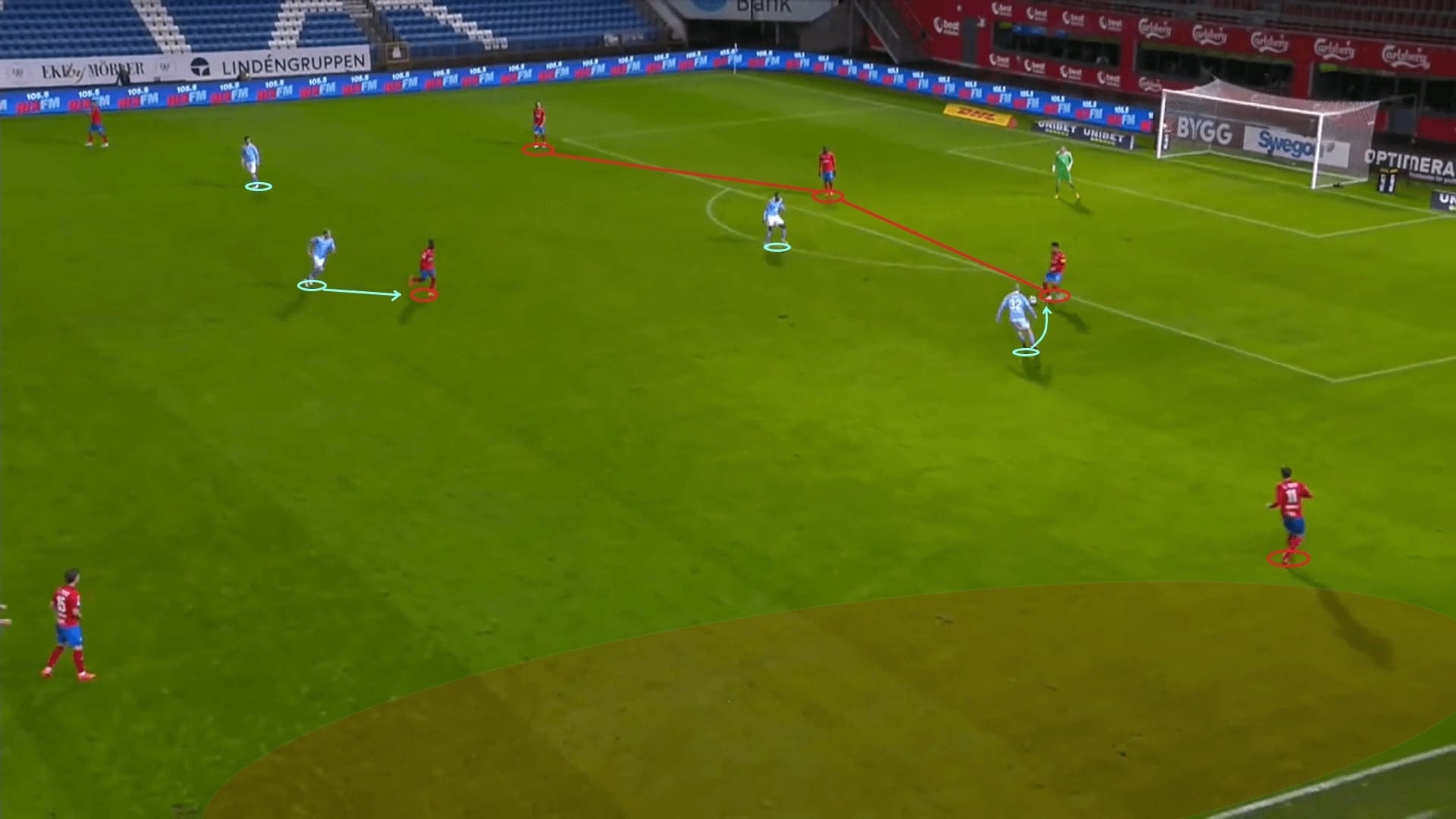
As the game went on, Olsson was more often became the main progressor for the home team. The left centre-back was comfortable to bring the ball forward to break the first line. Therefore, the rest of the team could push higher to occupy advanced areas on the pitch, including Eriksson and Max Svensson on the left.
Thanks to Olsson’s ball-carrying actions, the wingers could operate themselves as the additional midfielder at the half-spaces. Some combinations were available because of this setup. The below example shows the routes of Helsingborgs to generate a cross.
Firstly, Olsson brings the ball towards the midfield, drawing the midfielder out of position. He would have two options in that scenario – Svensson (vertical) and Eriksson (wide). In this game, Olsson tried to avoid playing to the left-back directly, as it would be more ideal if Eriksson could enter zone 16 at the right moment to deliver the cross.
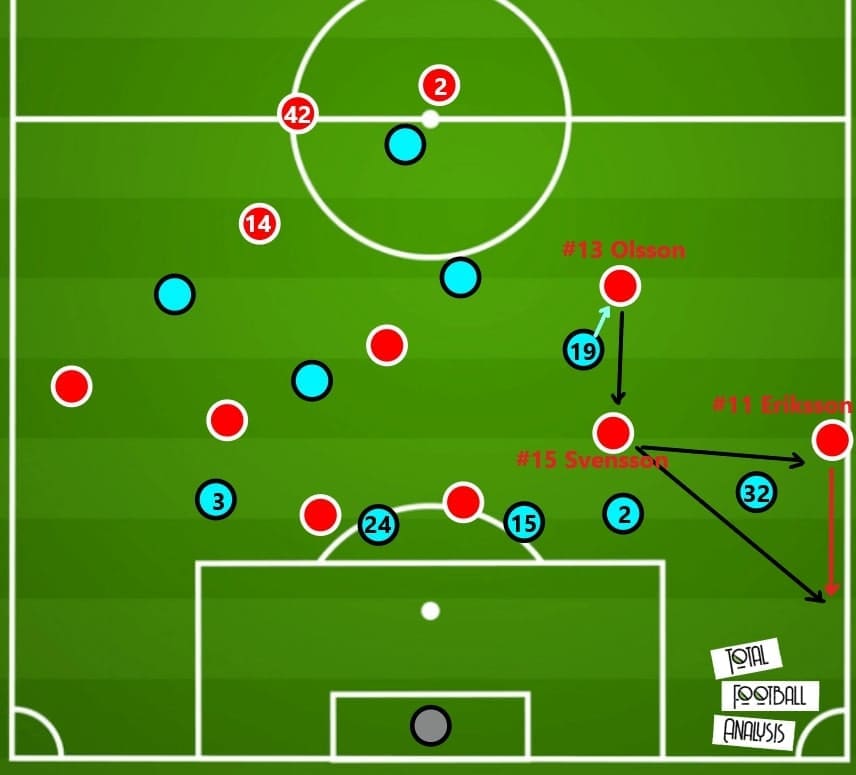
Since Inge Berget was defending almost like a wing-back in the first half, Helsingborgs were in-control in the middle third. The pattern could become even more unpredictable based on the reactions of the opponents. If Inge Berget attempted to step up early, spaces were opened in zone 16. Vice versa, if he dropped back initially, then Eriksson could still be found with another route.
However, it did not take long for Tomasson to discover the solution. The key was Inge Berget – the right-winger on paper. The key was the angle of the pressure. If it was the coming from the inside of the pitch, then, the wide pass was easy. Contrarily, the pressuring player should be able to shut the wide passing lanes if he was approaching from the outside.
The below example shows the situation after the details were fixed. Now, Erdal Rakip and Anders Christiansen were staying deeper as the double-pivot. Inge Berget must press Olsson early, ideally also curving the run to shut Eriksson. When Olsson carried the ball into the centre, he would find himself being caged by Malmö players. There was no way to get out unless the attacking players were extremely good at operating at tight spaces, which was not the case of Di Röe.
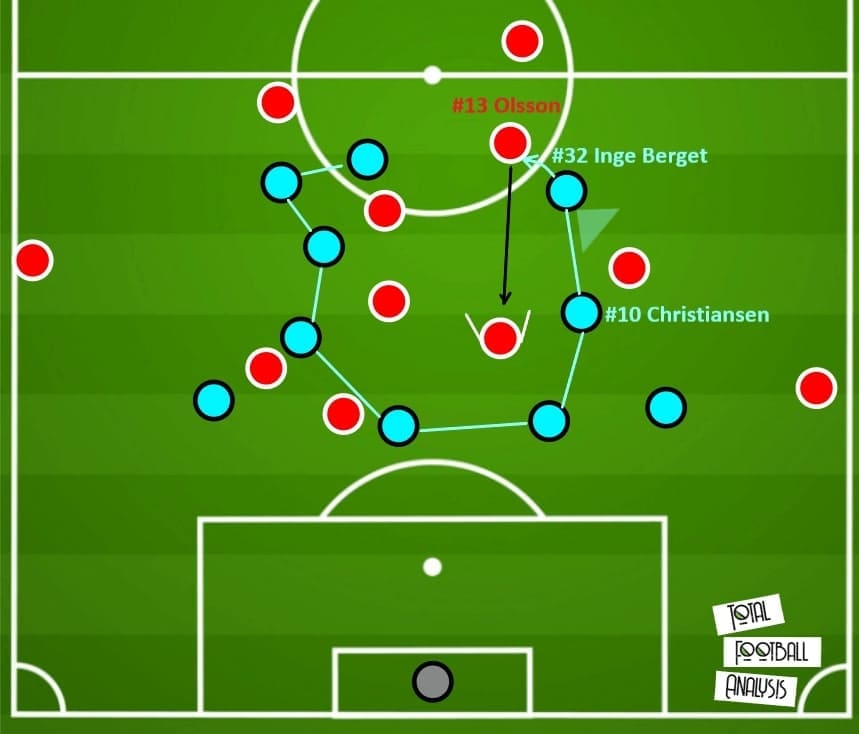
The contexts of the second half were slightly different. Malmö intended to attack more in the transitions, avoiding giving the ball away in the build-up plays. Defensively, the team put a lot of pressure to the back three of Helsingborgs, suffocating the above combinations initiated by Olsson. The substitution which introduced Søren Rieks was to keep the level of pressure high up on the pitch.
Inge Berget was required to press Olsson more often, even spaces to defend were large, hence, difficult to win the ball from the centre-back. The benefit of this change was to guide the direction of the attack. As shown below, Abubakari was unavailable because of under Kiese Thelin’s shadow and Toivonen’s marking. The only viable option was Eriksson, that was a predicted option and Rakip could anticipate the pass, hence, pressing the left-back early.
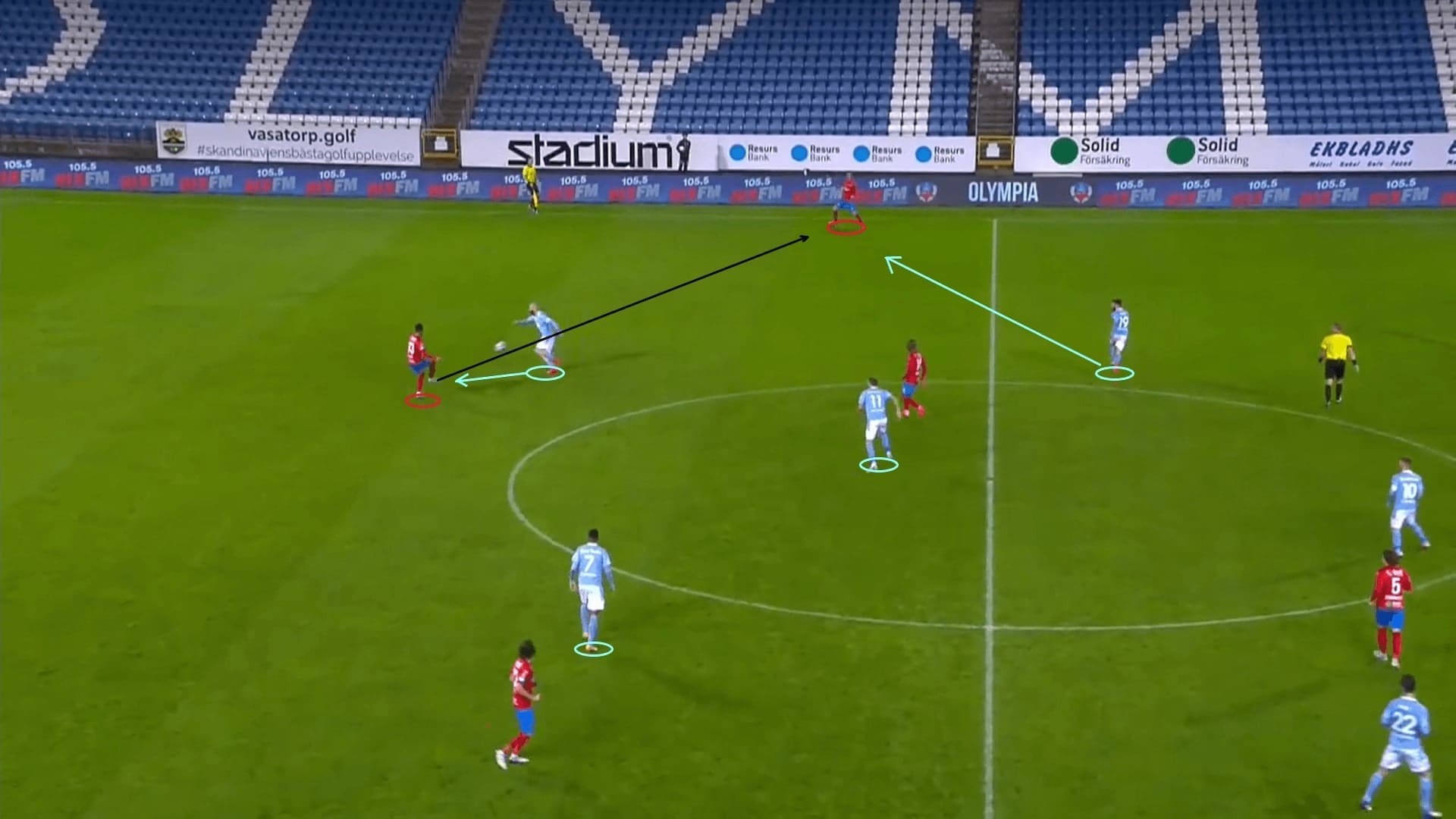
Below is another example of the pressing of Di blåe in the second half. After Rieks came on as the left-winger, Nalic played at the centre. On the right, Diskerud was also under the same level of pressure intensity as Tomasson wanted none of the wide centre-back could use the ball. Rieks was committed to the defensive duty, pressed the former Manchester City man from the outside of the pitch.
Perhaps to the only player could enjoy some free spaces was Tsouka but passing was not his strength. In the below example, when Diskerud tried to play short to Abubakari, the pass was read by Nalic, Malmö won the ball high and initiated a counter-attack.
Given the angle of pressure from Rieks, Malmö also nullified the verticality of Diskerud during offensive organizations. Therefore, Helsingborgs also tried direct plays to bypass the pressuring block early.
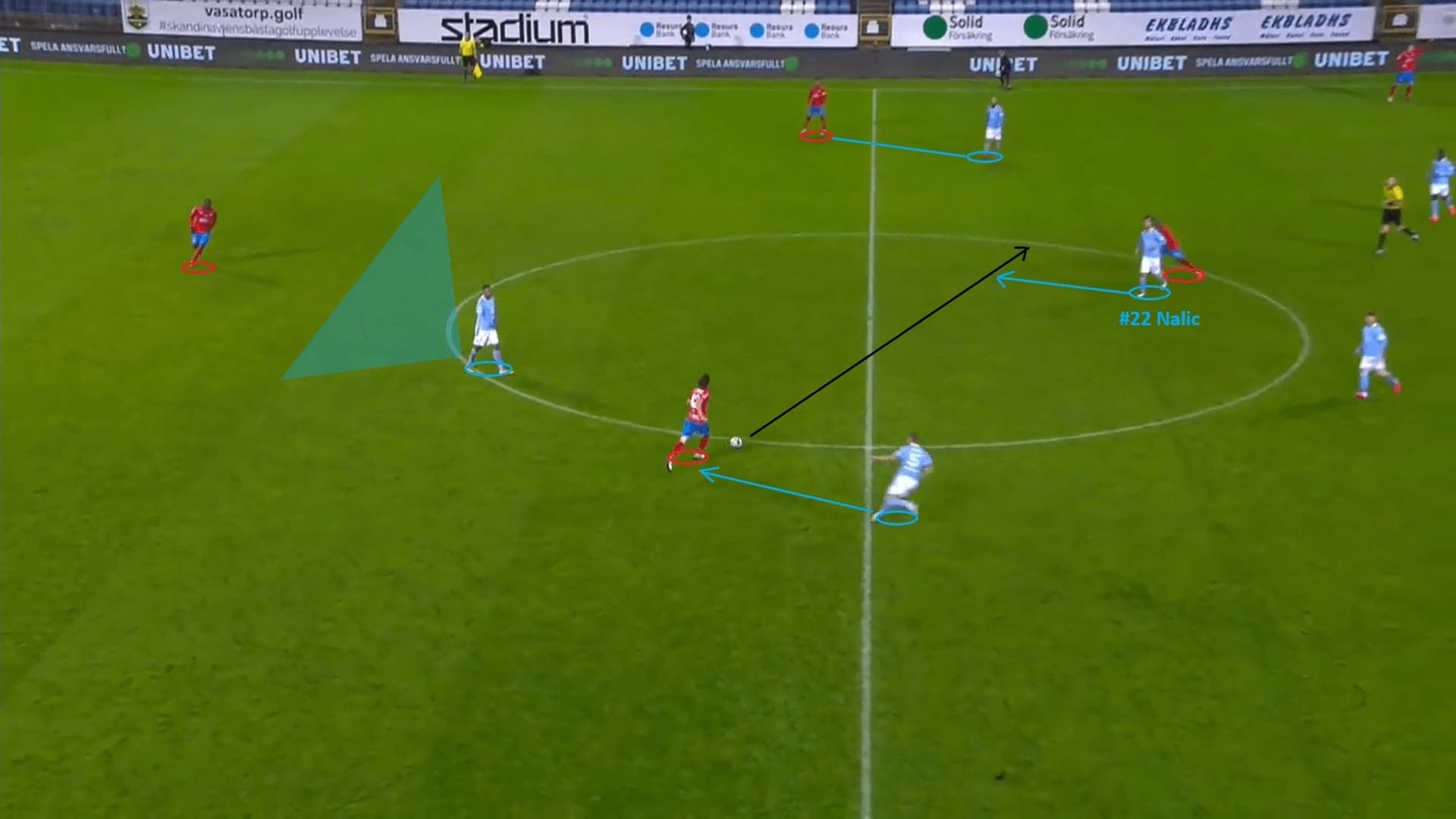
Direct plays of Helsingborgs
The strategy was to use Anthony van den Herk as the target, who dropped from the frontline to flip the ball. To fight for the second ball around the 27-year-old forward, at least his partner or the near-side winger would run behind him to look for the flip.
Sometimes the group included the left-back, Eriksson as well, which was even more ideal. The below situation is an example of this attack. Van den Hurk had 14 aerial duels in this game, more than the season average of 10.82, proving his role to offer another method for the team to access the final third.
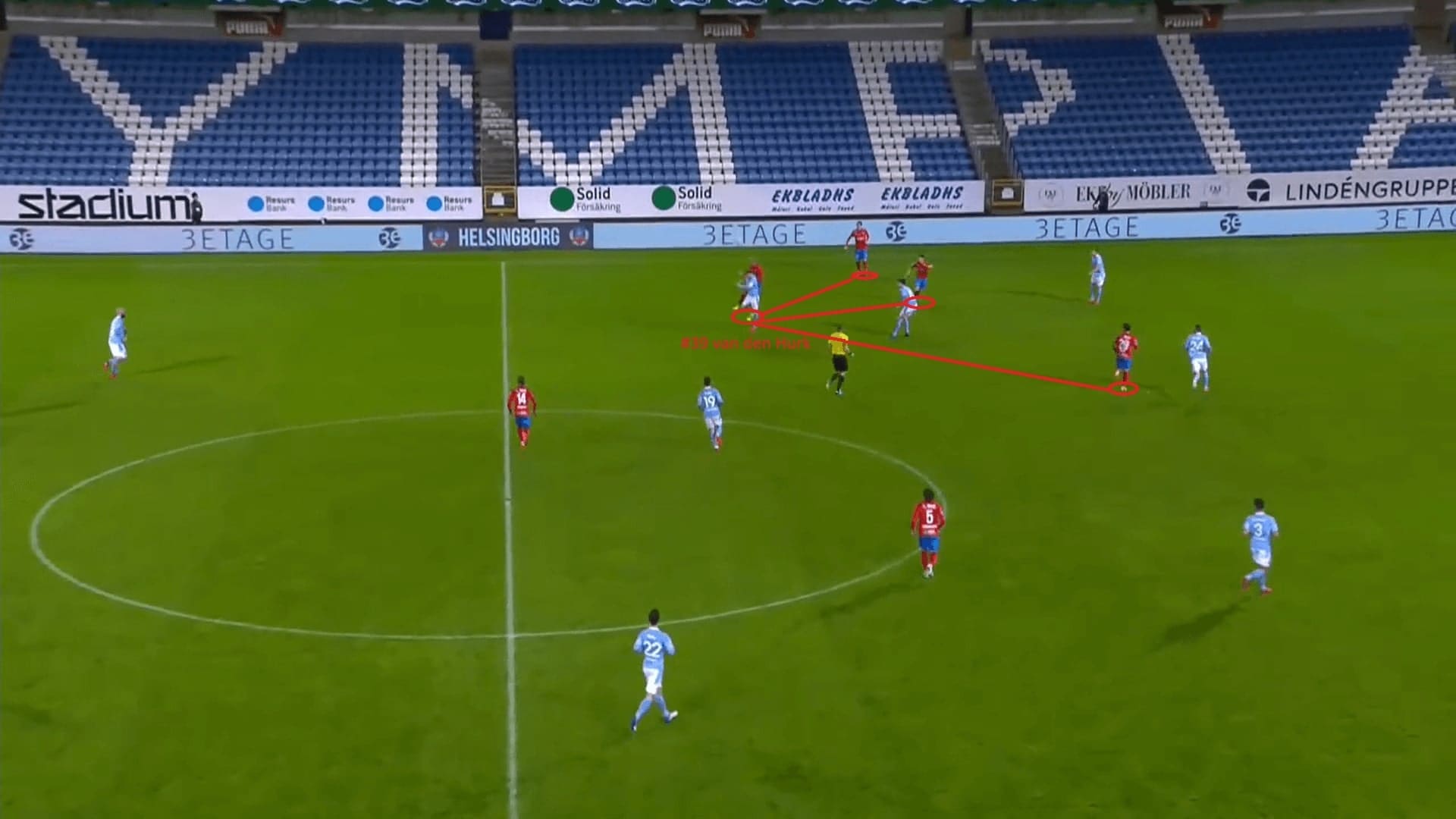
Mellberg had good knowledge of the passing-range and ability of Diskerud. The United States player was always encouraged to play long passes or cross-field balls in the final third. Di Röe were happy to cross early from the right as 8 from their 30 crosses came from zone 15. Diskerud provided a delicious one in the second half, as shown in this example.
On other occasions, Diskerud carried the ball forward to the right half-spaces, where we suggested his imaginary position below. In those cases, he would look for a switch to hit the underloaded left side, finding Eriksson and use the crossing routine.
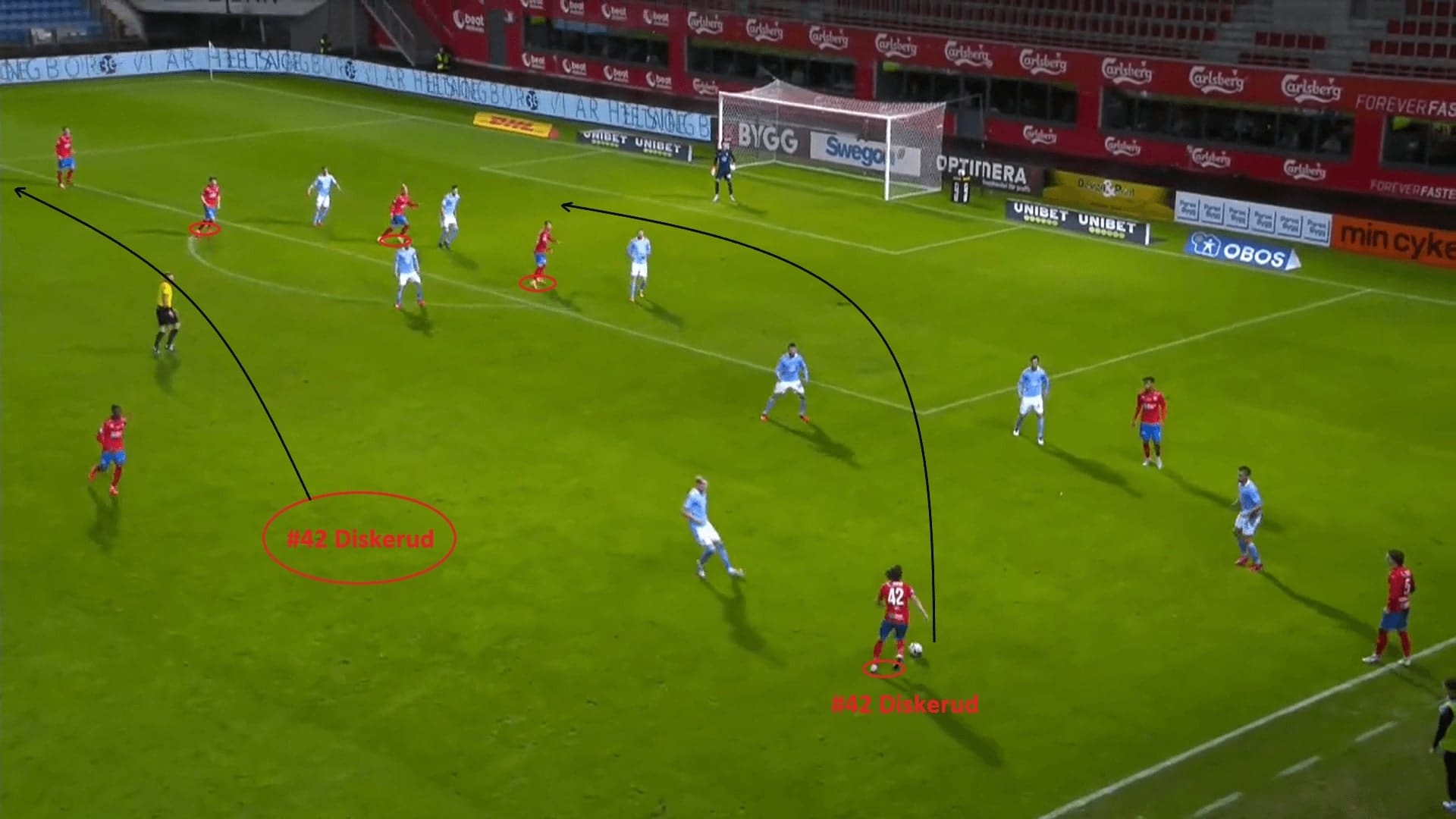
One point that Helsigborgs did well was to commit numbers when attacking the penalty zone. Apart from the strikers, at least a winger would enter the box as the target. The far side full-back was also encouraged to come from the flank, possibly attacking the far post or covering the rebound zone. This move should have good dynamism as the player, such as Eriksson below stayed on the blindside of the defence.
Therefore, Inge Berget must defend deeper to cover those spaces. This was also the reason that we suggested the right-winger sometimes defended liked a wing-back in the above analysis.
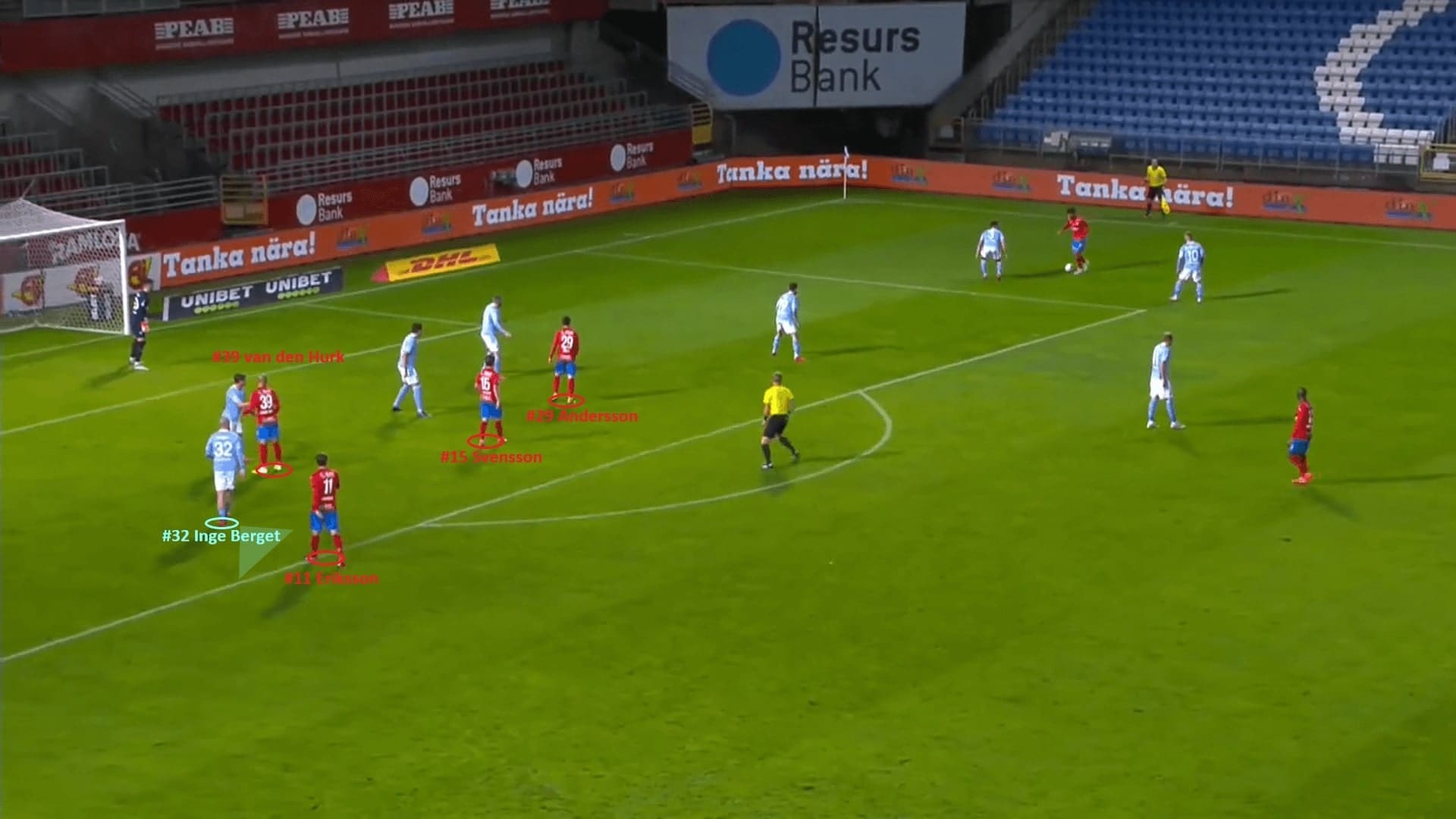
Final remarks
It was a close game but Malmö will take this one. Kiese Thelin’s only goal was the winner for the team, it was a one that he should be proud of, also his 12th in the league this season. They were one step closer to the champion, and it could happen in the coming week if they beat IK Sirius at home.
Helsingborgs would have to work harder to guarantee their seat in Allsvenskan 2021, it was still hopeful given the margin with Falkenburg FF was one-point only. The next opponent is IFK Göteborg, and Di Röe should have the chance to win the game.





Comments